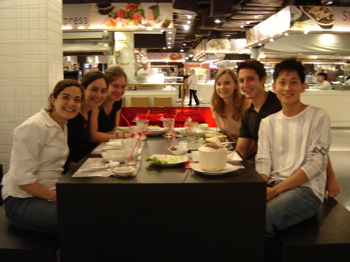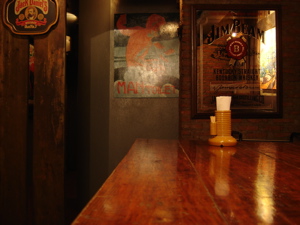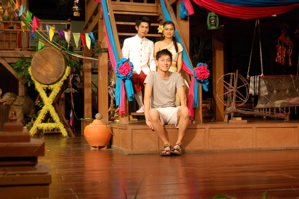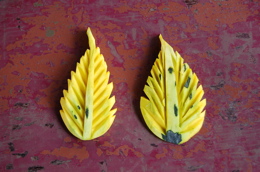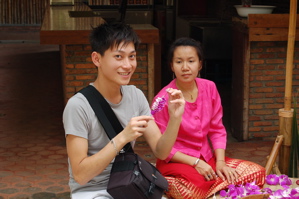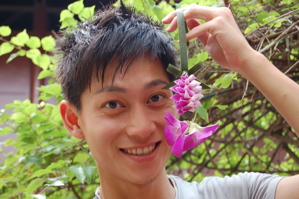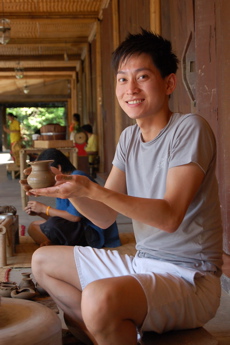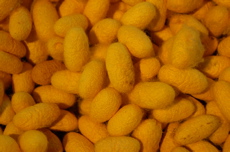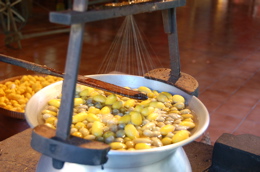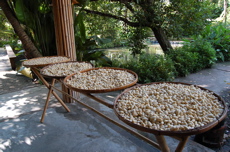One of the experiences that has been going through my mind a lot over the last few weeks is my meeting with Mr. Pongpol Adireksarn along with the other Fulbrighters. He has previously served as Minister of Education, Agriculture, Foreign Affairs, and Deputy PM (all separate positions, but some concurrent with others, I think), as well a couple of other posts. I remember these particular two because they were the positions that are most important to my research as well as that of one of the senior researchers doing work in Thailand’s political economy and the current and future role of agro-business here. At the time, I had only been in Thailand for about five weeks, so much of what he said went over my head. Still, I took some sparse notes about the things that I wasn’t really already familiar with. It is concerning these things that I will be writing for this particular entry. I should provide an advisory warning that this particular entry has the potential for causing extreme confusion and headache and that it took me two months to wrap my head around =). I am still learning about these issues on a daily basis, so do not be too concerned if I don’t make any sense. I’m using this as a way to work through my own understanding of the matter and am simply offering to take you all on the ride with me. Generous, aren’t I?
Khun Pongpol started out by welcoming all of the newest Fulbrighters to Thailand and asked us the usual round of questions such as how long we had been in Thailand and how we were liking it. He then provided a brief outline of what he had prepared to share with us that day, noting that there are three very important things we should know about Thailand and that once we understand them, we will understand Thai culture, society and people. Of course, this certainly encouraged us to pay attention since, as “farang,” we’re often baffled by some of the things we observe in a country that is at times infuriating, at times mysterious and oftentimes, wonderful. I should mention that Mr. Pongpol is an accomplished fiction writer and is well known in Thailand and whose work has been translated into a variety of other languages for audiences in other countries. Therefore, he certainly knows how to hook in an audience!
The three things are as follows: (1) Thailand is a monarchy; (2) Thailand is Buddhist; (3) Thai Ways. The first two are pretty self-explanatory and not nearly as important to what I’m trying to communicate in this particular entry. That is not to say that they’re not important, however. I mean, we can get technical and go into the fact that Thailand is actually a constitutional monarchy and has been since the very beginning of the current Chakri Dynasty and because of this, the development of democracy in Thailand has taken a unique path. On the role of Buddhism, I have yet to spend an adequate amount of time ruminating upon. Thus, the role of the monarchy and religion will have to be saved for another time and place. What I’m going to look at then, is the topic of “Thai ways.”
The reason I’m going into relative depth about these “Thai Ways” is because I believe that they play a crucial role in my research. They’re not directly related to economics, but once I’ve discussed them, my hope is that you too will see why I have latched onto them. Let’s not get ahead of ourselves here. I will return to his point once I’ve given you something to chew on. I’ll start by going through what I mean by “Thai Ways” and then examine two in particular. Then, I will go into how these two pieces of Thai culture can potentially underpin a great deal of my research here in Thailand. Finally, I’ll offer a blip on the implications of what I feel is a personal revelation for me. Gulp.
First, I should note that he didn’t actually use the term “Thai Ways,” it is my own addition and not even original at that. I borrowed it from the title of a book written on this very subject. It sounded to me like he said Thai Character or Characteristics, but for reasons you shall soon hopefully understand, nobody ventured forth and asked for clarification. In his explanation of the role of these “characteristics,” he mentioned two very specific terms. They are Thai terms and so I shall have to do my best to provide an explanation for them. In fact, my explaination may come across as almost philosophical and not entirely unlike a treatise on “Truth” with a capital T. It caused me to have a mini-flashback to freshman philosophy, when I studied Plato and Aristotle…[shudder].
The two terms are “Greng Jai” and “Man Sai.” Khun Pongpol explained that these two “feelings” underly all social interaction in Thai culture and are present in all relationships from those inside the familial unit throughout the entire government system. In short, they affect the way life works in Thailand. Now comes my attempt at describing them. Please pay close attention!
I apologize in advance to anybody out there who has a more firm understanding of them than I do and if you can explain it better than I can, please let me know =). One last tidbit of information I should share before I launch into the serious stuff is that there is an entire book written on these uniquely Thai characteristics. The book is called “Heart Talk” and is written by Christopher Moore. So if you’re intrigued by what I’m about to tell you, by all means, go get the book and let me borrow it when you’re done, heh heh ~

Greng jai can be very roughly translated as “consideration.” Let me give you the example that Khun Pongpol gave us. On a recent trip that required travel by airplane, Mr. Pongpol found that somebody was occupying his seat. He double-checked his ticket to make sure that he wasn’t the one who was mistaken. Nope, he was correct. Somebody was sitting in his seat. He then spoke with one of the female flight attendants and told her that somebody was in his seat. She replied that she was aware of the fact and that despite this, she doesn’t dare mention it to this other passenger. Think about that for a second. She doesn’t “dare” ask him to move. For our Western minds, this might seem a little baffling. Isn’t it her job to make sure that people are in the right seats and therefore ask them to move when they are in the wrong one? It turns out that the man occupying Khun Pongpol’s seat was an important government official and Khun Pongpol actually knew this, given his tenure in the civil service. So what happened? Well, Khun Pongpol walked right up to the man and said, “Hey! You’re in my seat!” The man checked his ticket, acknowledged his mistake (not sure if he apologized), and moved.
So let’s pick apart this scenario, shall we? Even though the air-hostess (as they are known here in Thailand) knew that he was in the wrong seat, she didn’t dare to say anything to the man. What you should know about Thailand is that it is a very socially hierarchical society that isn’t really clearly delineated. There are many indicators and qualities that one can possess that one can serve to place you on the giant totem pole of Thai society. However, how many points each of these things give you and how they are all combined to give you your social “score” is a still a mystery to me. Suffice it to say that like in any hierarchy, there are superiors and inferiors. In this case, social superiors and social inferiors. Some are easy. An older person is a social superior to a younger person. Your boss is your social superior. Men are socially superior to women outside the home (the reverse is true inside the home!). No comment on the rationale behind all of this.
Anyway, so the female air-hostess, as the social inferior to the male government official passenger, would have been violating social rules if she were to point out his mistake and ask him to change his seat. Social inferiors should never point out the mistakes of social superiors nor question their decisions. Maybe he didn’t like his seat and wanted to change. To me then, Greng jai almost seems like, “fear: or “knowing your place” as opposed to “consideration.” Hence my remark about it being a very rough translation. Another thing you should know is that sometimes, it’s hard to say what is appropriate. For example, given age and rank at the time, Khun Pongpol was also the social inferior of the other gentlemen, but given his previous posts, reputation, contacts, etc. he was able to break through the normal rules of contacts and point out the mistakes of a man who would be his social superior.
Confused yet? Greng jai often contributes to what many Westerners see in a critical light as a Thai’s tendency to either lie outright or be indirect and non-confrontational at all costs. Of course, the consideration aspect of it should not be ignored because it also applies to other situations. These of course, assume that you’re a Thai. For example, you’re riding on the skytrain (Bangkok’s ingenious version of a monorail, if only Seattle could get its act together) and you are fortunate enough to get a seat. Behind you is a little old Thai lady who finds that all the seats have been taken. You get up and offer her your seat in consideration of her age. That is also Greng jai. Or, you’re invited to somebody’s home and you’re invited to “make yourself at home.” This doesn’t mean that you can kick off your shoes and put your feet on the coffee table or take yourself on a tour of the home. Also, even if what you really want is a glass of that really expensive bottle of Cognac you see on the bar, you reply “water is fine, thank you.” See, I told you that this endeavor to explain the meaning of Greng jai is not unlike trying to explain the meaning of happiness.
Ok, next up, “Man Sai.” This one is a little easier, in my opinion. My own translation is that it is something like, “love-hate.” Still, it has its connection to Greng jai, so it is helpful that we’ve already gone over that. Man sai has to do with the feeling you get, as a social superior, when one of your juniors outshines you. Remember when I said that social inferiors should never complain nor should they questions the decisions of their social superiors? Well, this extends to the display of your abilities as well. You should never outperform or appear more competent than your superior, even if he or she is completely inept and a bumbling fool and would lead the company or organization to ruin if it were up to him or her. Again, let me emphasize that man sai is a feeling that is experienced by the social superior. It’s part embarrassment, part anger, part “well, I’ve never!” and part admiration. Usually, the superior feels this when, as the leader of a particular project or business unit, you are unable to solve a problem. But somehow, one of your junior members has the perfect solution and as somebody who has a lot the learn about Thai social interaction, blurted out the solution for all to hear at the last team meeting. Now, you’re relieved that you have the solution to your problem to present to your boss, but you’re also fairly embarrassed that your entire team knows that it wasn’t you, as the leader, who came up with the answer to everyone’s woes. Now you’re considering putting up a recommendation to HR that this precocious youngster be transferred to another branch in some far off province on account of insubordination or laziness. Thus, a young worker in who has just been accepted into government service or an office would do well to find subtle ways to reveal the location of the secret panacea to his boss’s problems if he doesn’t want to be transferred to Isan.
So now we can return to where we started and answer your questions as to how this has anything to do with why I’m in Thailand. How exactly ARE these observations related to my work and research in Thailand, you ask? Actually, it’s my opinion that understanding these aspects of Thai culture is crucial to my ability to get anything meaningful out of my time here. The discipline of economics, or the study of the production, consumption, transfer and allocation of a limited supply of resources, rests on an a priori assumption that these resources have VALUE to somebody. Economics teaches us that because of the value we place on said resources, we will BEHAVE in fairly predictable ways with regards to these resources; namely, we will act in such a way as to get obtain more resources = more is better. Economists also believe that we can predict with relative certainty how humans will behave. We can say that there is an assumed level of RATIONALISM and LOGIC involved in our behavior; we think about how we can apply the “more is better” concept and take actions that take us towards that goal. Thus, we can arrive at the conclusion that given how human values, logic, and rationalization all affect human behavior, we can start to look for their effects on the production, consumption, transfer and allocation of resources. Greng jai and man sai fall into the Thai value system and will therefore have an effect on the behavior of Thai people. In conclusion then, they will ultimately have an effect on the economic rules in place in Thailand.
To date, the bulk of economic thought and literature features the work of western minds. This is an important thing to keep in mind because I believe it follows then that the cognitive pathways that are purportedly “presupposed” when it comes to modern economic theory, rest upon essentially western thinking. One could argue that humans are humans no matter what part of the world they live in and therefore, have certain basics needs to fulfill. This is true. However, I think that to rule out the effects of culture and society on human economic behavior is a mistake.
What if the reason that economic theory seems to fall apart everywhere outside of the western world is because of the fact that to date, much of it is based on western modes of thinking? I mean, why is William Easterly of the World Bank’s book, “The Quest for Growth,” an account of adventures and misadventures in the tropics? Why have Nobel Prize winning economic models and formulas failed in practical application in the countries that need them to work the most? This is where my observations about Thai culture and society come into play: what if the influence of societal pressures, values, and mores is strong enough to change or suppress what would normally be considered rational behavior according to modern economic theory? Is it a surprise then that the models from which we are working, which assume that certain decisions will be made under given circumstances, fail when there are things outside of the model which affect said decisions? One can argue that the models are made to take into account the expected outcomes for the average person. But what if the average person and his or her values do not align with the definitions set out as part of the model’s underlying assumptions?
To give you some examples, let us revisit Greng jai and man sai. In a normal, capitalistic society that values merit, we would normally reward a worker bee who displays talent, ability and competency. In fact, we encourage discussion and differences of opinion and open dialogue. We generally feel that through disagreement, we are forced to consider many angles and possible solutions to a problem before we arrive at a decision. In the end, the team can feel comfortable proceeding because they’ve exercised due diligence in being proactive and anticipating outcomes. However, this process also takes a lot of time and energy. In Thai society, the decision making process is much more streamlined and simple – the boss makes all the decisions. No questions asked. Even if the worker bee sees a grave error in whatever the boss decides to do, Greng jai will keep him from saying anything about it. Moreover, if the worker bee is smart, he will make any good outcomes appear to be the sole handiwork of his boss.
If you throw in man sai to the mix, you will see another reason why Thai culture may appear to run counter to the logic of modern economic thought. Even if a young worker bee is talented and capable, he will do his best to hide it and not stand out too much from the rest of his co-workers. He will certainly do his utmost to make sure he never does anything to show up his boss. Again, there is always that possibility that he will arrive at work one day and find out that for some reason, he has been assigned to a post in a province far to the North, away from his friends, family and sweetheart.
When you live in a society that favors collectivism over individualism and rigid enforcement of its social hierarchy, how can you be expected to follow the rules set out by intellectuals in a completely different society that values just the opposite? This mental exercise that I’ve been engaged in the last couple of weeks has certainly been taxing. It’s not even just the words of Khun Pongpol that helped me to work through all of this. My teachers at the AUA and the people on Bangkok streets all seem to be telling me the same thing.
So, I guess what I got out of this whole thing was that, I’m exactly where I need to be right now in my life. This might sound a bit deterministic, but I’ve always been a believer that things happen to us for a reason. My seemingly random choice of majors appear to be coming together in a way I couldn’t have foreseen. My training in social history is giving me tools that are somewhat lacking in economics, as I’ve discussed at length. However, my training in economics is quite useful in helping me to understand the publications and numbers I have been coming across – these, I haven’t even touched upon because they’re meaningless without more analysis. I’m hoping that my exposure to the world of modern business will come into play here very soon. Through the help of various people I’ve talked to, I’ve been picking up some very interesting leads. Let’s not discount my personal cultural background as well. Growing up in a household where three languages were spoken and where the origins of my values are hard to trace (are they Chinese? Cambodian? American?) has certainly helped me to open up all of my senses to the world around me. Even though I’ve never been to Thailand before this trip and had really only known one Thai person in my life, I feel a peculiar affinity for the culture in which I am living and that there is a lot that I am identifying with. In short, I feel quite at home here. But worry not, I will come home someday =).










































